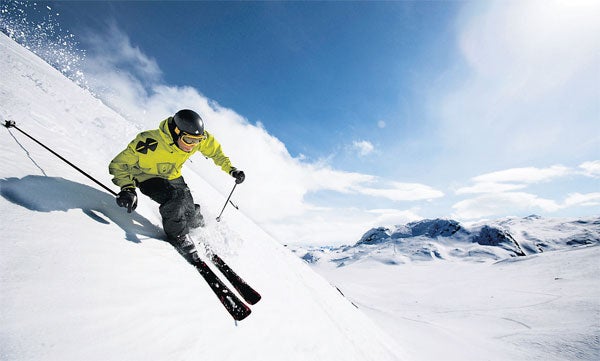The Independent's journalism is supported by our readers. When you purchase through links on our site, we may earn commission.
Time to head north: Swap high altitude for high latitude and you could be in for a treat

Come summertime, when people want to feel the sun on their backs, they turn to the south, through instinct – like migrating birds – or just habit. Come winter, when they want to feel soft snow beneath their skis, they turn... to the south.
It's a curious phenomenon. Everybody knows that the places where it's always cold, and the snow is thick on the ground, lie in the opposite direction; but the bulk of skiers still head south to the Alps.
But when the Alpine ski business was merely wringing its hands about the effect of climate change on low-lying ski areas, Swedish operator SkiStar ( skistar.com ) was already planning ahead, expanding its operations for the time when Scandinavians and others would prefer to ski in high-latitude, snow-sure resorts rather than risk going south to the high-altitude Alps.
Just after the millennium, when it had recently added Hemsedal in Norway to a portfolio of Are and Salen in Sweden, SkiStar was already the most profitable ski company in the world, according to one experienced UK ski entrepreneur I spoke to. Last season, when everyone else in the ski business was struggling, SkiStar saw its lift-ticket sales increase by 16 per cent in Sweden and 10 per cent in Norway; and, by June, accommodation sales in its resorts for 2009-10 were 27 per cent up on the previous year.
SkiStar's plan already seems to be working – although it is actually the global economy rather than global warming that is keeping Scandinavian skiers at home.
When it comes to downhill skiing, of course, altitude is fundamental, and Scandinavia's mountains fall far short of the Alps. For example, at Trysil, Norway's biggest and most popular resort (now a SkiStar property), the highest skiable point is at 1,100 metres, and the ski area has a drop of a mere 685 metres. It's a nice, civilised resort with good cruising runs, some of them fast enough to satisfy Michael Schumacher (who until recently had a chalet there); but it does lack challenge.
Indeed, comfortable skiing is the norm in Scandinavia, although there are some steep runs, notably the downhill course for the 1994 Winter Olympics at the Kvitfjell area near Lillehammer in Norway and the World Cup piste at Are. But the closest thing Scandinavia has to an Alpine resort is Hemsedal (highest skiable point: 1,450 metres), which has steep pitches on either side of the lower slopes which are tricky when ungroomed. Hemsedal also has the attraction of the Skarsnuten "design hotel".
Of course many Nordic skiers are unconcerned about slopes. Cross-country skiing is popular in Scandinavia: everybody does it, in part because running and jogging are not an option in the depths of winter. Every ski destination is criss-crossed by ski tracks, parallel grooves like tram lines, cut into the snow by machines.
In Arctic areas, there's a lot to be said for cross-country skiing. At Akaslompolo in Finland, the downhill skiing, on the slopes of Yllas, is limited – something of a blessing when a cold wind gets up. The alternative of generating your own momentum provides healthy exercise and much-needed warmth. The tracks are well-lit, and so useable in the dark days of winter. It is gratifying to feel at one with the natural environment as you swish through the trees. One evening at Akaslompolo, I stopped skiing to watch a herd of wild reindeer wander past me and cross on to a frozen lake.
An attempt at "tourism on skis" in the lakelands of central Finland was initially less successful, as my chosen destination, Jyvaskyla, turned out to have heating beneath its main streets and pavements. But out on the frozen lakes, skiing to see buildings by the architect Alvar Aalto went more smoothly.
Unlike the Alps, Scandinavia has hardly any purpose-built ski destinations. Most "resorts" are based upon old settlements, so there's usually something interesting to do off the slopes.
But the most appropriate destination for UK skiers is probably Are, where SkiStar has cunningly tuned the valley's five villages to meet the needs of different market sectors, from families to twenty-something party-goers. It also has an extensive ski area. But Riksgransen in Sweden, on the border with Norway and well inside the Arctic Circle, is most remarkable.
Many Nordic resorts have long winter-sport seasons: Hemsedal, for example, is usually open for six months, from November to May. But because the days are so short in midwinter, Riksgransen doesn't open for snowboarding until February; and it stays open until the summer, when the days are so long that you can heliski at midnight. Riksgransen (which translates as "state line") is not easily accessible, but is well worth the detour. Its Lapplandia restaurant is exceptional.
Further information
Regrettably, among the main ski tour operators, rystal, Thomson and First Choice no longer include Scandinavian resorts in their brochures; but Inghams (020-8780 4433; inghams.co.uk ) has a family-orientated programme in Norway and Finland, and Neilson (0845-070 3460; neilson.co.uk ) offers ski holidays in Finland, Norway and Sweden.
Subscribe to Independent Premium to bookmark this article
Want to bookmark your favourite articles and stories to read or reference later? Start your Independent Premium subscription today.

Join our commenting forum
Join thought-provoking conversations, follow other Independent readers and see their replies